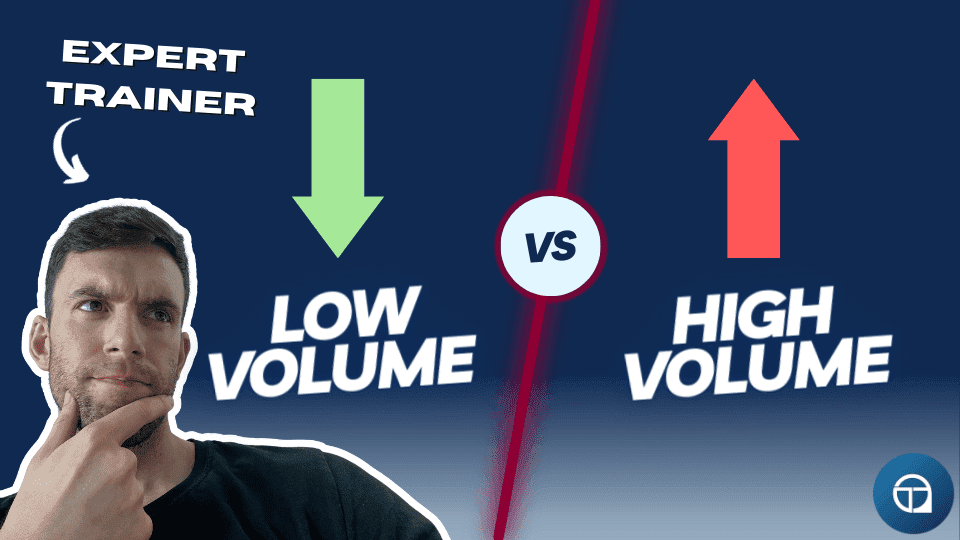Should you do high volume or low volume for muscle growth? This is one of those questions that gets endlessly debated in health and fitness circles, and there are strong opinions on both sides. When we take on new coaching clients, we see people very often paralysed into inaction trying to decide between following a high volume or low volume approach. So if you are trying to utilise the best methods you can to build more muscle, what should you be doing? Should you be prioritising increasing the amount of overall volume you are doing (as measured by working sets) or should you be prioritising a low volume of training, but have that training be more intense (closer to failure)?
Let’s get stuck into it!
Should You Do High Volume Or Low Volume For Muscle Growth?
When we talk about the discussion you see online around low-volume versus high-volume training approaches, the real crux of the issue is, how many working sets should you do, and then, how close to failure should you take those sets. Should you be doing a lower number of sets, or should you be doing a higher number of sets? However, the reality of the situation is, it kind of doesn’t matter. Well yes, it does matter and we’ll get into that, but across your training life, across your training career, you’re probably going to go through periods of lower training volume, periods of higher training volume, and that’s perfectly fine. You shouldn’t be married to one system. Rather, you should focus on the overarching principles, and the overall understanding of resistance training, so that you can actually modify your training program to get the results that you want. This is what we try to teach our clients when they come to us for coaching, as we want them to be able to actually coach themselves in the future without us being there to hold their hand.
With that in mind, you do see a lot of arguments online about this topic, and you see a lot of people advocate for a lower volume approach, and a lot of people advocate for a higher volume approach. You see a lot of pro-bodybuilders who used a lower volume approach got great results. You see a lot of bodybuilders that used high volume training and got great results. So, who’s actually right? And as we kind of alluded to, they’re both kind of right.
First of all, different people respond differently to different stimuli. Someone might find that they actually respond a little bit better to a lower volume approach, while someone else finds that they respond a little bit better to a higher volume approach. And by respond, I don’t just mean in terms of the results they are able to get, but also in terms of how they actually engage with the training program and how they enjoy it. And that is unfortunately just what we have to deal with when we’re talking about stuff like training program design because you’re going to have to build an understanding of your body, how you respond to training, how you respond to a well set up diet, how much sleep you need, and how you have to manage your stress, etc.
This does make it very confusing and very hard to actually get a clear answer because you can always kind of just wave your hands and say, “Yeah, like there are inter-individual responses, so, you know, everything works.” But that doesn’t really help you understand how you should structure your training program. So, we need to develop a kind of framework for thinking about this.
In general, the research does seem to suggest that somewhere in the range of 10 to 20 sets per muscle group per week seems to be a good place to be for muscle building. So, if that’s the case, we now just have to think, “Okay, I’m going to have to allocate volume for my chest, my back, my quads, my hamstrings, glutes, calves, biceps, triceps, etc.” You can break it down by body part and allocate volume. Now, there is obviously some crossover between movements and the muscles they train, like you train your back, you’re training your biceps a little bit. So, how do you actually count the volume there for the biceps?
But for right now, we don’t need to get sidetracked by these more nuanced arguments, we need to think more generally. We know that somewhere in the region of 10 to 20 sets per body part per week seems to make sense for muscle building. Right? Cool. We can use that as the framework, and a sort of scaffolding for this discussion.
When we’re talking about, “Oh, should you do a lower volume, higher volume, etc.,” you probably want to stay somewhere in that region of 10-20 sets per body part per week. Now, whether you prefer to stay closer to the bottom range (i.e. you’re doing ~10 sets), or you prefer to stay closer to the top range (i.e. you’re doing 20 sets), you are still in and around the sweet spot.
Now, it should be noted that there is a potential benefit to more sets above and beyond that, but then you really have to look at the overall program structure. You have to ensure that if you’re training, let’s say, quads for 30 sets, you have to make sure that you’re not trying to train your chest, your back, your biceps, and everything else for 30 sets as well. You’re going to have to take into account more systemic fatigue as a result.
All right, so 10 to 20 sets per body part seems to be the sweet spot. Now, if you look at big bodybuilders that use a low-volume or high volume approach, they generally seem to fall within that. Now, some of them do go higher, and some of them go lower, but generally, the vast majority of them do seem to fall somewhere in that region across the week.
Now you might say, “Oh, but what about X bodybuilder or Y bodybuilder? They did this, so is that breaking this rule?”
Well, no. First of all, it’s kind of a soft rule. You might be able to get away with a little bit less, you might be able to get away with a little bit more. But that doesn’t mean that that’s the case for everyone and oftentimes, especially on the low volume approach, you see people say, “Oh, I do a very low volume approach. I do one set per exercise, and maybe I do three exercises for that body part.” But very often, you also see them doing a lot of warm-up sets, a lot of hard warm-up sets at that, which other people might just actually count as actually working sets. While they may not be counting them as working sets, in reality, they just did a lot of hard sets (often close to failure) and just ramped up the intensity (relative percentage of their rep max) across those sets And so, we have to take that into account.
While the waters get very muddied with all this stuff, for the vast majority of people 10 to 20 sets per body part per week seems to be a good place to be. Generally, we probably want to stay in the region of 3 to 10 sets per workout per body part, per workout and try to space the workouts out across the week to maximize recovery. And as a result of that, we can say you’re probably more likely to build muscle. However, you, as an individual, may find certain levels of volume, that you respond better to. You might find lower volume suits your mentality, your physiology, and your psychology a lot better than higher volume, and vice versa. And that’s okay. Ultimately, once you are generally in and around that 10-20 sets per body part per week, you are generally in the sweet spot and you are likely to make muscle-building progress.
How Much Volume For Muscle Growth Summary
So any of these discussions you see online of whether you should follow an approach of high volume or low volume for muscle growth, or discussion where people say, “I follow this approach, so it must be the best approach”, you can look at these discussions and think, that’s probably not someone who has trained a lot of people. That’s probably not someone who has really had to deal with changes in training across a life cycle, across a lifespan, and doesn’t fully understand the variables that go into an effective training program.
So hopefully you have a better idea of training programming and are now able to answer the question of whether you should do high volume or low volume for muscle growth. If you need help with your own training, we do offer online coaching and we have spaces available. So if you want to not only get results, but actually learn how to set up an effective training program for your goals, then coaching may be for you. You can find more of our content by searching the website, or following us on YouTube.

Paddy Farrell
Hey, I'm Paddy!
I am a coach who loves to help people master their health and fitness. I am a personal trainer, strength and conditioning coach, and I have a degree in Biochemistry and Biomolecular Science. I have been coaching people for over 10 years now.
When I grew up, you couldn't find great health and fitness information, and you still can't really. So my content aims to solve that!
I enjoy training in the gym, doing martial arts and hiking in the mountains (around Europe, mainly). I am also an avid reader of history, politics and science. When I am not in the mountains, exercising or reading, you will likely find me in a museum.


